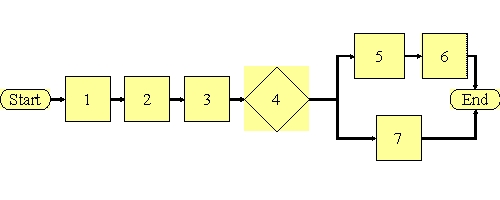Multiple Choice
A medical equipment testing and calibration service is depicted in Figure 1. The customer usually brings the equipment to the service center. The service process requires service technicians to perform three process steps #1 to #3. Each technician is cross-trained so they can perform any of the three steps. The inspector does Step # 4 alone. After step #4, two parallel work activities are performed. That is, a shipping clerk packs the work (step 7) while a billing clerk prepares the invoice (step 5) simultaneously, and the customer is contacted by phone for pick-up (step 6) . The average throughput is 3 equipment units per hour.  Figure 1 Flow chart of the medical equipment testing and calibration service process
Figure 1 Flow chart of the medical equipment testing and calibration service process
The table below shows the work content of the process steps, activity times in minutes per unit, shared and non-shared work activities, and the type of resource required. There are 3 service technicians on duty: 1 inspector, 1 billing clerk, and 1 shipping clerk.
-The service rate in units per hour for the service technician is _____ units per hour.
A) 1.2
B) 2.4
C) 3.6
D) 7.5
Correct Answer:

Verified
Correct Answer:
Verified
Q79: A focused factory is least likely to
Q80: The earliest revenue management systems focused solely
Q81: An assembly line normally operates two shifts
Q82: All the following are means to adjust
Q83: For a nonbottleneck activity:<br>A) utilization must be
Q84: Explain the concept of a focused factory.
Q86: A pharmacy lab is used for
Q87: Long-term capacity planning must be closely tied
Q88: In service organizations, capacity is more often
Q89: Define economies of scale and diseconomies of